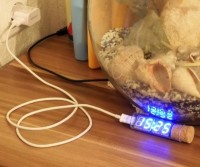Clock-In-A-Tube

This is ... a clock in a tube. The the pcb fits in a 24mm tube. The cork ist used to operate the functions. Powered by a workless phone charger.
One day, when I unplugged my phone from the charger, I wondered what else the charger could do the whole day?
Why not powering a clock?
But it should be something unusual.
So, when this 24mm diameter plastic tubes, closed with a cork came into my way, I decided to use it as a housing for the clock.
This is some other kind of TUBE-clock.
The prototype was build onto a piece of veroboard. It used one of the china fake DS1302 clock modules with battery backup, a ATmega328P microcontroller and some 7-segment LED displays found in my pile of materials. The displays were perfect. They filled the available space in the tube.
The time setting is done by two buttons that are placed in a way, that they can be opperated by twisting the cork. Therefore a slit is made into the cork, so that the cork can reach over the pcb and buttons.
Additionally, I built a simple stand out of a piece of scrap wood.
After the prototype was working good, I decided to create a proper and clean pcb, also as a KiCad practice. I also used a better and genuine clock chip, the PCF8563.
While not connected to the charger, the clock is kept running by a coin cell battery back-up.
The software was made with Atmel-Studio. It is pure and doesn't use Arduino stuff.
Features
More info to follow...
Why not powering a clock?
But it should be something unusual.
So, when this 24mm diameter plastic tubes, closed with a cork came into my way, I decided to use it as a housing for the clock.
This is some other kind of TUBE-clock.
The prototype was build onto a piece of veroboard. It used one of the china fake DS1302 clock modules with battery backup, a ATmega328P microcontroller and some 7-segment LED displays found in my pile of materials. The displays were perfect. They filled the available space in the tube.
The time setting is done by two buttons that are placed in a way, that they can be opperated by twisting the cork. Therefore a slit is made into the cork, so that the cork can reach over the pcb and buttons.
Additionally, I built a simple stand out of a piece of scrap wood.
After the prototype was working good, I decided to create a proper and clean pcb, also as a KiCad practice. I also used a better and genuine clock chip, the PCF8563.
While not connected to the charger, the clock is kept running by a coin cell battery back-up.
The software was made with Atmel-Studio. It is pure and doesn't use Arduino stuff.
Features
- unusual design
- powered by a otherwise workless phone charger
- operated by twisting the cork on the tube
- using only two push-buttons
- different levels of brightness can be set
- programmable automatic time correction (compensate crystal offset)
- battery back-up
More info to follow...



Updates vom Autor